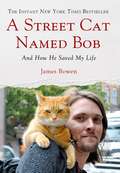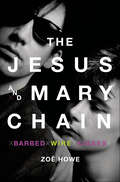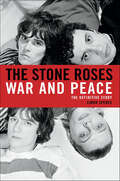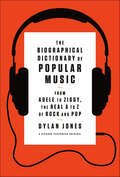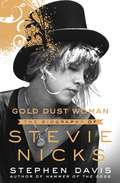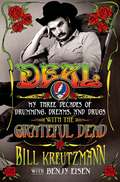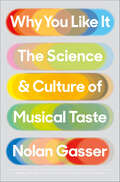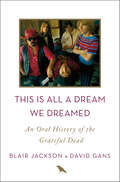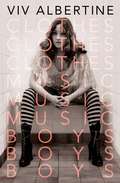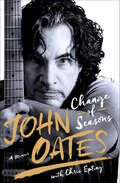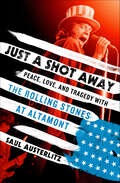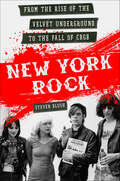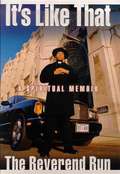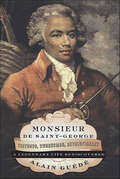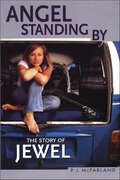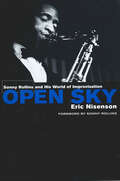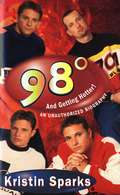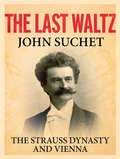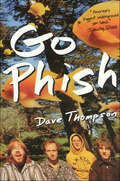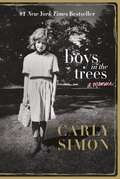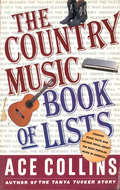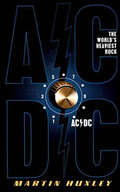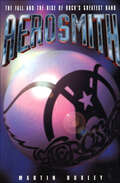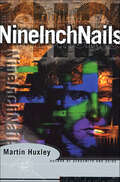- Table View
- List View
A Street Cat Named Bob: And How He Saved My Life
by James BowenThe Instant New York Times Bestseller! James is a street musician struggling to make ends meet. Bob is a stray cat looking for somewhere warm to sleep. When James and Bob meet, they forge a never-to-be-forgotten friendship that has been charming readers from Thailand to Turkey. A Street Cat Named Bob is an international sensation, landing on the bestseller list in England for 52 consecutive weeks and selling in 26 countries around the world. Now, James and Bob are ready to share their true story with the U. S. in this tale unlike any you’ve ever read of a cat who possesses some kind of magic. When street musician James Bowen found an injured cat curled up in the hallway of his apartment building, he had no idea how much his life was about to change. James was living hand to mouth on the streets of London, barely making enough money to feed himself, and the last thing he needed was a pet. Yet James couldn't resist helping the strikingly intelligent but very sick animal, whom he named Bob. He slowly nursed Bob back to health and then sent the cat on his way, imagining that he would never see him again. But Bob had other ideas. Perfect for fans of Marley & Me: Life and Love with the World's Worst Dog and Dewey: The Small-Town Library Cat That Changed the World, this instant classic about the power of love between man and animal has taken the world by storm and is guaranteed to be a huge hit with American fans as well. Note: Does not use standard American spelling or punctuation.
The Jesus and Mary Chain: Barbed Wire Kisses
by Zoë HoweMusically, culturally and even in terms of sheer attitude, the Jesus and Mary Chain stand alone. Their seminal debut album Psychocandy changed the course of popular music, and their iconic blend of psychotic white noise and darkly surreal lyrics that presaged the shoegaze movement continues to enchant and confound.Zoë Howe's biography is the fierce, frank and funny tale of the Jesus and Mary Chain, told by the band members and their associates for the very first time. The story begins in the faceless town of East Kilbride, near Glasgow, at the dawn of the 1980s with two intense, chronically shy brothers, Jim and William Reid, listening to music in their shared bedroom. What follows charts an unforgettable journey complete with incendiary live performances, their pivotal relationship with Alan McGee's Creation Records and those famous fraternal tensions—with plenty of feedback, fighting, and crafting perfect pop music along the way. It is high time this vastly influential group and sometime public enemy had their say.
The Stone Roses: War and Peace: The Definitive Story
by Simon SpenceThe Stone Roses captures the magic—and chaos—behind the UK band's rise, fall, and recent resurrection.The iconic Brit pop band The Stone Roses became an overnight sensation when their 1989 eponymous album went double platinum. It was a recording that is still often listed as one of the best albums ever made. Its chiming guitar riffs, anthemic melodies, and Smiths-like pop sensibility elevated The Stone Roses to a cult-like status in the UK and put them on the map in the U.S. But theirs is a story of unfulfilled success: their star imploded as their sophomore effort took years to complete and the band broke up acrimoniously in 1996. Sixteen years later, they reunited and have been playing sold out gigs, thrilling fans around the globe, and working on new material. In 2013, they nabbed the coveted headline spot at the Coachella Festival. With one hundred interviews of key figures, forty rare photographs, and exclusive insider material including how they created their music, The Stone Roses charts the band's rise from the backwaters of Manchester to becoming the stars of the "Madchester" scene to their successful comeback years later. Going beyond the myths to depict a band that defined Brit pop, Simon Spence illustrates their incandescent talent and jaw-dropping success while contextualizing them in the 90s music scene. This is the definitive story of The Stone Roses.
The Biographical Dictionary of Popular Music: From Adele to Ziggy, the Real A to Z of Rock and Pop
by Dylan JonesThe Biographical Dictionary of Popular Music is an incredible and opinionated collection of celebrated cultural critic Dylan Jones's thoughts on more than 350 of the most important artists around the world—alive and dead, big and small, at length and in brief. This A to Z reference is the true musical heir to David Thomson's seminal The New Biographical Dictionary of Popular Film. Jones writes entertainingly about bands that have inspired, bedeviled, and fascinated him over the years.
Gold Dust Woman: The Biography of Stevie Nicks
by Stephen Davis<p>Stevie Nicks is a legend of rock, but her energy and magnetism sparked new interest in this icon. At sixty-nine, she's one of the most glamorous creatures rock has known, and the rare woman who's a real rock ‘n' roller.</p> <p>Nicks' work and life are equally sexy and interesting, and Davis delves deeply into each, unearthing fresh details from new, intimate interviews and interpreting them to present a rich new portrait of the star. Just as Nicks (and Lindsey Buckingham) gave Fleetwood Mac the "shot of adrenaline" they needed to become real rock stars―according to Christine McVie―Gold Dust Woman is vibrant with stories and with a life lived large and hard.</p>
Deal: My Three Decades of Drumming Dreams and Drugs with the Grateful Dead
by Bill Kreutzmann Benjy EisenThe Grateful Dead are perhaps the most legendary American rock band of all time. For thirty years, beginning in the hippie scene of San Francisco in 1965, they were a musical institution, the original jam band that broke new ground in so many ways. From the music to their live concert sound systems and fan recordings, they were forward-thinking champions of artistic control and outlaw artists who marched to the beat of their own drums.<P><P> Bill Kreutzmann, one of their founding members and drummer for every one of their over 2,300 concerts has written an unflinching and wild account of playing in the greatest improvisational band of all time. Everything a rock music fan would expect is here, but what sets this apart is Bill's incredible life of adventure that was at the heart of the Grateful Dead experience. This was a band that knew no limits and Bill lived life to the fullest, pushing the boundaries of drugs, drums and high times, through devastating tragedy and remarkable triumph.<P> But at this book's beating heart is the music--theirs and others. Some of the greatest musicians and concerts were a part of the Grateful Dead's career, from sharing the stage with Janis Joplin, Bob Dylan, and The Who, to playing in the Acid Tests, The Monterey Pop Festival, Woodstock and Altamont. Bill's life is a chronicle of American music and pop culture history and his epic personal journey is one of sonic discovery and thrilling experiences.
Why You Like It: The Science & Culture of Musical Taste
by Nolan GasserFrom the chief architect of the Pandora Radio’s Music Genome Project comes a definitive and groundbreaking examination of why we respond to music the way we do.Everyone loves music. But what is it that makes music so universally beloved and have such a powerful effect on us? In this sweeping and authoritative book, Dr. Nolan Gasser—a composer, pianist, and musicologist, and the chief architect of the Music Genome Project, which powers Pandora Radio—breaks down what musical taste is, where it comes from, and what our favorite songs say about us. Dr. Gasser delves into the science, psychology, and sociology that explains why humans love music so much; how our brains process music; and why you may love Queen but your best friend loves Kiss. He sheds light on why babies can clap along to rhythmic patterns and reveals the reason behind why different cultures around the globe identify the same kinds of music as happy, sad, or scary. Using easy-to-follow notated musical scores, Dr. Gasser teaches music fans how to become engaged listeners and provides them with the tools to enhance their musical preferences. He takes readers under the hood of their favorite genres—pop, rock, jazz, hip hop, electronica, world music, and classical—and covers songs from Taylor Swift to Led Zeppelin to Kendrick Lamar to Bill Evans to Beethoven, and through their work, Dr. Gasser introduces the musical concepts behind why you hum along, tap your foot, and feel deeply. Why You Like It will teach you how to follow the musical discourse happening within a song and thereby empower your musical taste, so you will never hear music the same way again.
The Cake and The Rain: A Memoir
by Jimmy WebbJIMMY WEBB'S words have been sung to his music by a rich and deep roster of pop artists, including Glen Campbell, Art Garfunkel, Frank Sinatra, Donna Summer, and Linda Ronstadt. He's the only artist ever to win Grammy Awards for music, lyrics, and orchestration, and his chart-topping career has, so far, lasted fifty years, most recently including a Kanye West rap hit and a new classical nocturne. Now, in his first memoir, Webb delivers a snapshot of his life from 1955 to 1970, from simple and sere Oklahoma to fast and fantastical Los Angeles, from the crucible of his family to the top of his longed-for profession. Webb was a preacher's son whose father climbed off a tractor to receive his epiphany, and Jimmy, barely out of his teenage years, sank down into the driver's seat of a Cobra to speed to Las Vegas to meet with Elvis. Classics such as "Up, Up and Away," "By the Time I Get to Phoenix," "Wichita Lineman," "Galveston," "The Worst That Could Happen," "All I Know," and "MacArthur Park" were all recorded by some of the most important voices in pop before Webb's twenty-fifth birthday--and he thought it was easy. The sixties were a supernova, and Webb was at the center, whipsawed from the proverbial humble beginnings into a moneyed and manic international world of beautiful women, drugs, cars, and planes. That stew almost took him down, but Webb survived, his passion for music and work among his lifelines. The Cake and the Rain is a surprising and unusual book; Webb's talent as a writer and storyteller is on every page. His book is rich with a sense of time and place, and with the voices of characters, vanished and living, famous and not, but all intimately involved with him in his youth, when life seemed nothing more than a party and Webb the eternal guest of honor. "America's songwriter," is the author of the musician's bible Tunesmith: Inside the Art of Songwriting (on Bookshare and on BARD). Webb's songs, with their complex chord structure, have been recorded or performed by artists from Frank Sinatra to Carly Simon to REM. He tours extensively, performing his own works and stories in the United States and around the world. He was the youngest man ever inducted into the Songwriters' Hall of Fame and was named by Rolling Stone magazine as one of the top fifty songwriters of all time. A father of six and grandfather of one, Webb lives with his wife, Laura Savini, in New York.
This Is All a Dream We Dreamed: An Oral History of the Grateful Dead
by David Gans Blair JacksonIn This Is All a Dream We Dreamed, two of the most well-respected chroniclers of the Dead, Blair Jackson and David Gans, reveal the band’s story through the words of its members, their creative collaborators and peers, and a number of diverse fans, stitching together a multitude of voices into a seamless oral tapestry. Capturing the ebullient spirit at the group’s core, Jackson and Gans weave together a musical saga that examines the music and subculture that developed into its own economy, touching fans from all walks of life, from penniless hippies to celebrities, and at least one U.S. vice president. This definitive book traces the Dead’s evolution from its humble beginnings as a folk/bluegrass band playing small venues in Palo Alto to the feral psychedelic warriors and stadium-filling Americana jam band that blazed all the way through to the 90s. Along the way, we hear from many who were touched by the Dead—from David Crosby and Miles Davis, to Ken Kesey, Carolyn “Mountain Girl” Garcia, and a host of Merry Pranksters, to legendary concert promoter Bill Graham, and others. Throughout their journey the Dead broke (and sometimes rewrote) just about every rule of the music business, defying conventional wisdom and charting their own often unusual course, in the process creating a business model unlike any seen before. Musically, too, they were pioneers, fusing inspired ideas and techniques with intuition and fearlessness to craft an utterly unique and instantly recognizable sound. Their music centered on collective improvisation, spiritual and social democracy, trust, generosity, and fun. They believed that you can make something real, spontaneous, and compelling happen with other musicians if you trust and encourage each other, and jam as if your life depended on it. And when it worked, there was nothing else like it.Whether you’re part of the new generation of Deadheads who are just discovering their music or a devoted fan who has traded Dead tapes for decades, you will want to listen in on the irresistible conversations and anecdotes shared in these pages. You’ll hear stories you haven’t heard before, possibly from voices that may be unfamiliar to you, and the tales that unfold will shed a whole new light on a long and inspiring musical odyssey.
Clothes, Clothes, Clothes. Music, Music, Music. Boys, Boys, Boys.: A Memoir
by Viv AlbertineVIV ALBERTINE is a pioneer. As lead guitarist and songwriter for the seminal band The Slits, she influenced a future generation of artists, including Kurt Cobain and Carrie Brownstein. She formed a band with Sid Vicious and was there the night he met Nancy Spungeon. She tempted Johnny Thunder.... toured America with The Clash... dated Mick Jones... and inspired the classic Clash anthem "Train in Vain." But Albertine was no mere muse. In Clothes, Clothes, Clothes. Music, Music, Music. Boys, Boys, Boys., Albertine delivers a unique and unfiltered look at a traditionally male-dominated scene. Her story is so much more than a music memoir. Albertine's narrative is nothing less than a fierce correspondence from a life on the fringes of culture. The author recalls rebelling from conformity and patriarchal society ever since her days as an adolescent girl in the same London suburb of Muswell Hill where the Kinks formed. With brash honesty--and an unforgiving memory--Albertine writes of immersing herself into punk culture among the likes of the Sex Pistols and the Buzzcocks; of her devastation when The Slits broke up and her reinvention as a director and screenwriter; of abortion, marriage, motherhood, and surviving cancer; navigating infidelity and negotiating divorce; and launching her recent comeback as a solo artist with her debut album, The Vermilion Border. This is a raw chronicle of music, fashion, love, sex, feminism, and more that connects the early days of punk to the Riot grrl movement and beyond. But even more profoundly, Viv Albertine's remarkable memoir is the story of an empowered woman staying true to herself and making it on her own in the modern world. Her first solo album, The Vermilion Border, was released in 2012 to great critical acclaim. This is her autobiography.
Change of Seasons: A Memoir
by Chris Epting John Oates“One is struck . . . by how talented [Oates] was [and] how hard he worked at it. It took lots of effort to look that smooth to the tune of 80 million copies.” —Austin American-StatesmanJohn Oates was born at the perfect time, paralleling the birth of rock ‘n roll. Raised in a small Pennsylvania town, he was exposed to folk, blues, soul, and R&B. Teaming up with Daryl Hall in the late 1960s, they developed a style of music that was uniquely their own. John uncovers the grit and struggle it took to secure a recording contract with the legendary Atlantic Records and chronicles the artistic twists and turns that resulted in a DJ discovering an obscure album track that would become their first hit record. This is not your typical rock and roll story. John was focused on creating great music. Along the way he achieved incredible success, battling the ever-changing pop music landscape and coming to terms with complex managerial, business, and personal challenges.Daryl Hall and John Oates have over 20 albums together, more than 60 million records sold, and 29 Top 40 hits. They are the most successful pop duo in the world and members of the Rock and Roll Hall of Fame. And yet John’s story has never been told. Relying on his many hand-written journals, he brings to light many fascinating stories spanning his entire life with a journalist’s eye and a poet’s heart.“Fascinating. . . . Highly recommended for fans of Hall & Oates.” —Library Journal“Plenty of entertaining anecdotes.” —Publishers Weekly“An exceedingly entertaining, somewhat rueful chronicle of his life. . . . Andy Warhol, Michael Jackson, David Bowie, Lou Reed, Quincy Jones, Miles Davis, and Edgar Winter all make appearances.” —Booklist, starred review
Just a Shot Away: Peace, Love, and Tragedy with the Rolling Stones at Altamont
by Saul Austerlitz“The most blisteringly impassioned music book of the season.” —New York Times Book ReviewA thrilling account of the Altamont Festival—and the dark side of the ‘60s.If Woodstock tied the ideals of the '60s together, Altamont unraveled them. In Just a Shot Away, writer and critic Saul Austerlitz tells the story of “Woodstock West,” where the Rolling Stones hoped to end their 1969 American tour triumphantly with the help of the Grateful Dead, the Jefferson Airplane, and 300,000 fans. Instead the concert featured a harrowing series of disasters, starting with the concert’s haphazard planning. The bad acid kicked in early. The Hells Angels, hired to handle security, began to prey on the concertgoers. And not long after the Rolling Stones went on, an 18-year-old African-American named Meredith Hunter was stabbed by the Angels in front of the stage.The show, and the Woodstock high, were over. Austerlitz shows how Hunter’s death came to symbolize the end of an era while the trial of his accused murderer epitomized the racial tensions that still underlie America. He also finds a silver lining in the concert in how Rolling Stone’s coverage of it helped create a new form of music journalism, while the making of the movie about Altamont, Gimme Shelter, birthed new forms of documentary. Using scores of new interviews with Paul Kantner, Jann Wenner, journalist John Burks, filmmaker Joan Churchill, and many members of the Rolling Stones' inner circle, as well as Meredith Hunter's family, Austerlitz shows that you can’t understand the ‘60s or rock and roll if you don’t come to grips with Altamont.
New York Rock: From the Rise of The Velvet Underground to the Fall of CBGB
by Steven BlushSteven Blush's New York Rock presents the definitive history of a key period in rock ‘n’ roll, from new wave to no wave, punk to punk revival, from the bestselling author of American Hardcore. As a city that represents endless possibilities, New York has been the setting for the dawning of new movements, styles, and genres. In the 20th century, the birth of Rock represented a connection between art forms and the city’s socioeconomic, racial, and sexual variants. New York Rock breaks down the rock scene’s half-century connection to New York and analyzes its distinct subculture through the prism of influences, crosscurrents and psychoactive distractions. Over 1,500 musicians, clubs, and labels, from Madonna to the Ramones, held roles in the making of New York Rock, and it’s their contributions that created this iconic art form. A compilation of firsthand narratives about each genre of rock, from Punk New Wave and Glitter Rock to New York Hardcore and Indie rock, New York Rock is the ultimate illustrated account of Rock’s role in New York City.
It's Like That
by Joseph Simmons RunMoney, success, and widespread adulation: Run of Run-DMC, one of the first rappers to achieve nationwide recognition and top-selling albums, seemed to have it all in his heyday. But the dizzying effects of fame soon left Run feeling empty and dissatisfied. Stuck in a pit of despair, he went through the motions of his public life while grappling with his loss of direction and a family life that was falling apart. Here is the story of how he turned his life around, discovering a wellspring of spirituality within himself and a special connection with God. Now an ordained minister, Run talks in this extraordinary book about his profound life change and getting the message out to the community. Still a major rap performer, with an album entitled Crown Royal and frequent appearances on MTV, Run is truly a rennaissance man. A spiritual memoir unlike any other, It's Like That captures the innocence of youth, the pain of chaos, and the joy that one can only find through righteous living. This is an epic and absorbing tale from one of the most popular and complex performers of our times.
Monsieur de Saint-George: Virtuoso, Swordsman, Revolutionary: A Legendary Life Rediscovered
by Alain GuédéThe first full biography of one of the greatest figures of eighteenth-century Europe, known in his time as the "Black Mozart"Virtually forgotten until now, his life is the stuff of legend. Born in 1739 in Guadeloupe to a slave mother and a French noble father, he became the finest swordsman of his age, an insider at the doomed court of Louis XVI, and, most of all, a virtuosic musician. A violinist, he directed the Olympic Society of Concerts, which was considered the finest in Europe in an age of great musicians, including Haydn, from whom he commissioned a symphony, and Mozart, to whom he was often compared. He also became the first Freemason of color, embracing the French Revolution with the belief that it would end the racism against which-despite his illustrious achievements-he struggled his whole life. This is the life of Joseph Bologne, known variously as Monsieur de Saint-George, the "Black Mozart," and, because of his origins, "the American." Alain Guédé offers a fascinating account of this extraordinary individual, whose musical compositions are at long last being revived and whose story will never again be forgotten.
Angel Standing By: The Story of Jewel
by P. J. McFarland"There really aren't mistakes. Be very adventurous and brave in your life. Love bravely, live bravely, be courageous--there's really nothing to lose. There's no wrong you can't make right again, so be kind to yourself. . . There are no bounds." --JewelAngel Standing By offers an intimate, behind-the-scenes look at the struggles and successes of Jewel Kilcher, who in a few short years went from living in her van near the beach in San Diego to becoming a multiplatinum recording artist and nationally best selling author. With personal photographs and exclusive interview material, this fascinating account is not to be missed by any fan moved by the music of Jewel.
Open Sky: Sonny Rollins and His World of Improvisation
by Eric NisensonSonny Rollins is arguably the most influential tenor saxophonist that jazz has produced. He began his musical career at the tender age of eleven, and within five short years he was playing with the legendary Thelonius Monk. In the late forties (before his twenty-first birthday), Rollins was in full swing, recording with jazz luminaries such as Charlie Parker, Bud Powell, Max Roach, Art Blakey, Miles Davis, and Fats Navarro. He was hailed as the best jazz tenor saxophonist alive during the years 1955 to 1959, when he was credited with pioneering the use of 3/4-time in bop music.Today, forty years later, Rollins's onstage appearances are eagerly anticipated events, where his compelling sound reaches a whole new generation of listeners. Renowned jazz writer Eric Nisenson has penned a long-overdue look at one of jazz music's brightest and most enduring stars.
98 Degrees...
by Kristin SparksDrew, Jeff, Nick and Justin. They're four fine guys who are taking the music world by storm with their winning combination of R&B and pop. Where did they come from? Where do they see themselves going? What inspires their fabulous songs? And what's going on in their personal lives? Find out the sizzling inside story on this scorchingly sexy band!
The Last Waltz: The Strauss Dynasty and Vienna
by John SuchetCaptured in a beautiful package, including more than fifty color photographs, The Last Waltz tells the intriguing story of of the Viennese Strauss family known for producing some of the best known, best loved music of the nineteenth century. Johann and Josef Strauss, the Waltz Kings, composed hundreds of instantly recognizable and enduringmelodies, including The Blue Danube Waltz, Tales from the Vienna Woods, Voices of Spring and The Radetzky March. Their iconic music has been featured on the scores of nearly a thousand films.Yet despite their success, this was a family riven with tension, feuds and jealousy, living in a country that was undergoing seismic upheaval. Through the personal and political chaos, the Strauss family continued to compose music to which the Viennese - anxious to forget their troubles - could dance and drank champagne, even as their country hurtled towards oblivion at the hands of the First World War. Classical music expert and radio host John Suchet skillfully portrays this gripping story, capturing the family dramas, the tensions, triumphs and disasters against the turbulent backdrop of Austria in the nineteenth century, from revolution to regicide.
Go Phish
by Dave ThompsonOn Halloween night 1983, at an ROTC dance on a college campus deep in the heart of Vermont, the band subsequently known as Phish played their very first gig.It was a total disaster.But it was the beginning of an era. Here's the whole story.
Boys in the Trees: A Memoir
by Carly SimonSimon's memoir reveals her remarkable life, beginning with her storied childhood as the third daughter of Richard L. Simon, the co-founder of publishing giant Simon & Schuster, her musical debut as half of The Simon Sisters performing folk songs with her sister Lucy in Greenwich Village, to a meteoric solo career that would result in 13 top 40 hits, including the #1 song "You're So Vain." She was the first artist in history to win a Grammy Award, an Academy Award and a Golden Globe Award, for her song "Let the River Run" from the movie Working Girl. The memoir recalls a childhood enriched by music and culture, but also one shrouded in secrets that would eventually tear her family apart. Simon brilliantly captures moments of creative inspiration, the sparks of songs, and the stories behind writing "Anticipation" and "We Have No Secrets" among many others. Romantic entanglements with some of the most famous men of the day fueled her confessional lyrics, as well as the unraveling of her storybook marriage to James Taylor.
The Country Music Book of Lists
by Ace CollinsMore than just charts, star bios, and boring listings, "The Country Music Book of Lists" is the perfect gift or pop reference guide for trivia fans, filled with humor, insight, and "down home fun".
AC/DC: The World's Heaviest Rock
by Martin HuxleyOver the decades, AC/DC has carved out a unique niche in the rock world. Thanks to their stubborn refusal to alter their aggressive, in-your-face style that has been their stock in trade, they have emerged as one of the essential cornerstones of contemporary hard rock. Frank, humorous, and accurate, this full-blooded biography takes a look this tenacious Australian quintet.
Aerosmith: The Fall and the Rise of Rock's Greatest Band
by Martin HuxleyIn Aerosmith, Martin Huxley chronicles the fall and the rise of rock's greatest band. Read about the origins of mega rockstars Steven Tyler, Joe Perry, Tom Hamilton, Brad Whitford, and Joey Kramer--from the group's near break-up to their path of success that would eventually lead to them to Rock and Roll Hall of Fame.
Nine Inch Nails
by Martin HuxleySound, throb, and a long low wail of pure, hard pain... Nine Inch Nails. The world's most disturbing rock band is in effect one man singer and songwriter Trent Reznor. Since stealing the show during the original Lollapalooza tour in 1991, NIN has limned the hard edge of the techno revolution. In Reznor's desperate, combative persona and disarrayed melodies the musical community has finally found a band that appalls, confounds, and undeniably attracts. Horrified yet entranced, NIN's fans are like moths drawn toward the disfiguring flame of their music. From a well of previously unpublished research, Huxley has carved out the history of this improbable hero: Reznor's rise as an Appalachian outcast to dyspeptic sex symbol; his connections to Courtney Love; and his relationship with his spasmodically fixated fans. Ricocheting wildly between goth rock and industrial grunge, Nine Inch Nails has achieved a legendary sound. Here, Martin Huxley digs hard and deep to unearth the truth beneath the ultimate noise.
